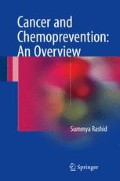Abstract
Oxygen is a blessing for the existence of all the aerobic organisms on earth. Nevertheless, it plays an adverse role in biological systems by involving the phenomenon of oxidative stress. In biological systems, oxygen constantly undergoes metabolic reactions to generate oxygen-derived free radicals in the form of superoxide (O2−), hydroxyl (OH), alkoxyl (RO), and peroxyl (RO2) plus non-radicals in the form of hydrogen peroxide (H2O2), peroxynitrite (ONOO–), hypochlorous acid (HOCl), and hypobromous acid (HOBr). Reactive species are divided into four groups depending on the main atom involved: ROS, reactive nitrogen species (RNS), reactive sulfur species (RSS), and reactive chloride species (RClS); their half-lives vary from a few nanoseconds to hours depending on the stability of the molecule. During intracellular metabolic processes like electron transport chain, ROS and RNS are also produced. Normal physiological state in a living system is achieved by a proper equilibrium between the generation and neutralization of ROS and does not lead to any oxidative damage (Roberts et al. 2009). A group of researchers illustrated that an imbalance between the generation of ROS (prooxidant) and antioxidant defense system leads to oxidative stress.
Access this chapter
Tax calculation will be finalised at checkout
Purchases are for personal use only
References
Ahmad ST, Arjumand W, Seth A et al (2011) Preclinical renal cancer chemopreventive efficacy of geraniol by modulation of multiple molecular pathways. Toxicology 290:69–81
Dayem AA, Choi HY, Kim JH et al (2010) Role of oxidative stress in stem, cancer, and cancer stem cells. Cancers (Basel) 2:859–884
Esra B, Umit MS, Cansin S et al (2012) Oxidative stress and antioxidant defense. World Allergy Organ J 5:9–19
Khan R, Khan AQ, Qamar W et al (2012) Chrysin abrogates cisplatin induced oxidative stress, p53 expression, goblet cell disintegration and apoptotic responses in the jejunum of Wistar rats. Br J Nutr 108:1574–1585
Kumar S (2011) Free radicals and antioxidants: human and food system. Adv Appl Sci Res 2:129–135
Poljsak B, Šuput D, Milisav I (2013) Achieving the balance between ROS and antioxidants: when to use the synthetic antioxidants. Oxid Med Cell Longev 2013;Article ID 956792, 11 pages
Rashid S, Ali N, Nafees S et al (2013a) Abrogation of 5-flourouracil induced renal toxicity by bee propolis via targeting oxidative stress and inflammation in Wistar rats. J Pharm Res 7:189–194
Rashid K, Sinha K, Sil PC (2013b) An update on oxidative stress-mediated organ pathophysiology. Food Chem Toxicol 62:584–600
Roberts RA, Laskin DL, Smith CV (2009) Nitrative and oxidative stress in toxicology and disease. Toxicol Sci 112:4–16
Roberts RA, Smith RA, Safe S (2010) Toxicological and pathophysiological roles of reactive oxygen and nitrogen species. Toxicology 276:85–94
Toyokuni S (2008) Molecular mechanisms of oxidative stress-induced carcinogenesis: from epidemiology to oxygenomics. IUBMB Life 60:441–447
Author information
Authors and Affiliations
Rights and permissions
Copyright information
© 2017 Springer Science+Business Media Singapore
About this chapter
Cite this chapter
Rashid, S. (2017). Oxidative Stress-Induced Carcinogenesis. In: Cancer and Chemoprevention: An Overview. Springer, Singapore. https://doi.org/10.1007/978-981-10-2579-2_7
Download citation
DOI: https://doi.org/10.1007/978-981-10-2579-2_7
Published:
Publisher Name: Springer, Singapore
Print ISBN: 978-981-10-2578-5
Online ISBN: 978-981-10-2579-2
eBook Packages: Biomedical and Life SciencesBiomedical and Life Sciences (R0)

